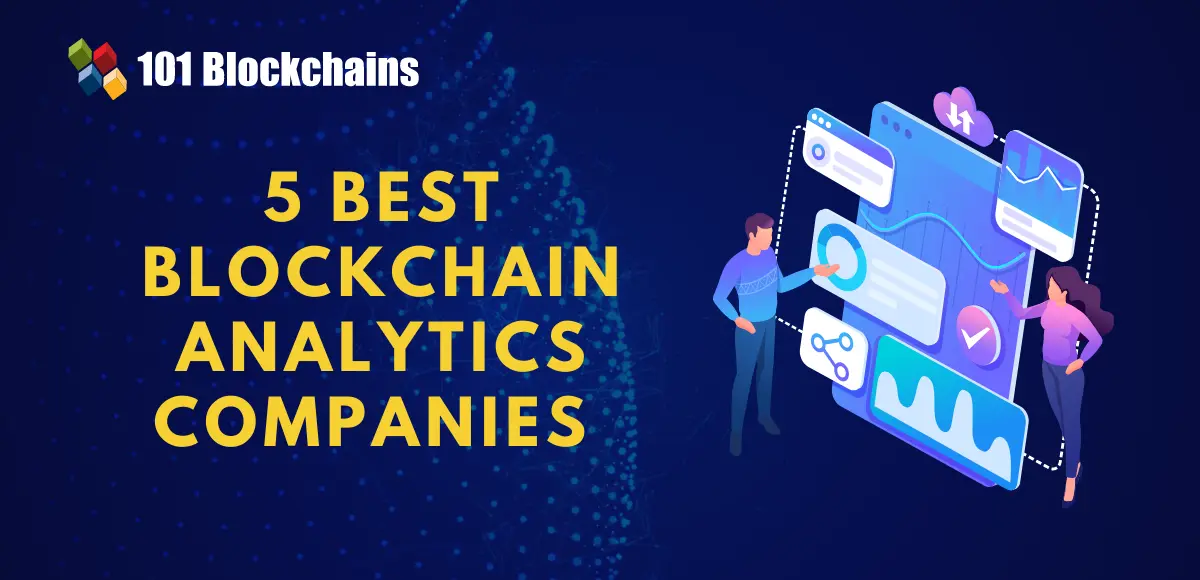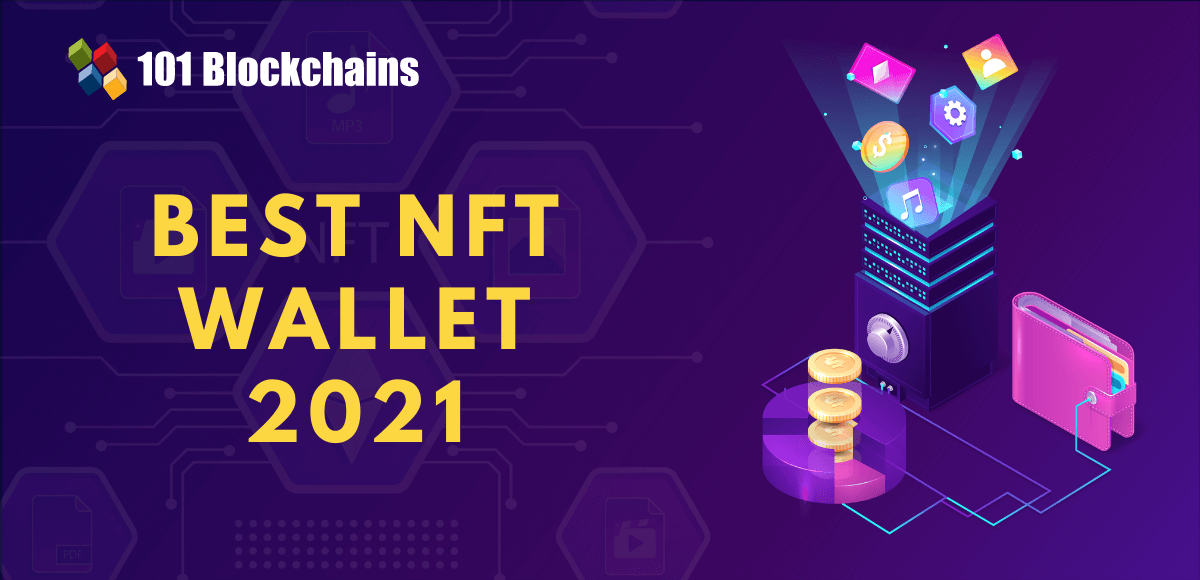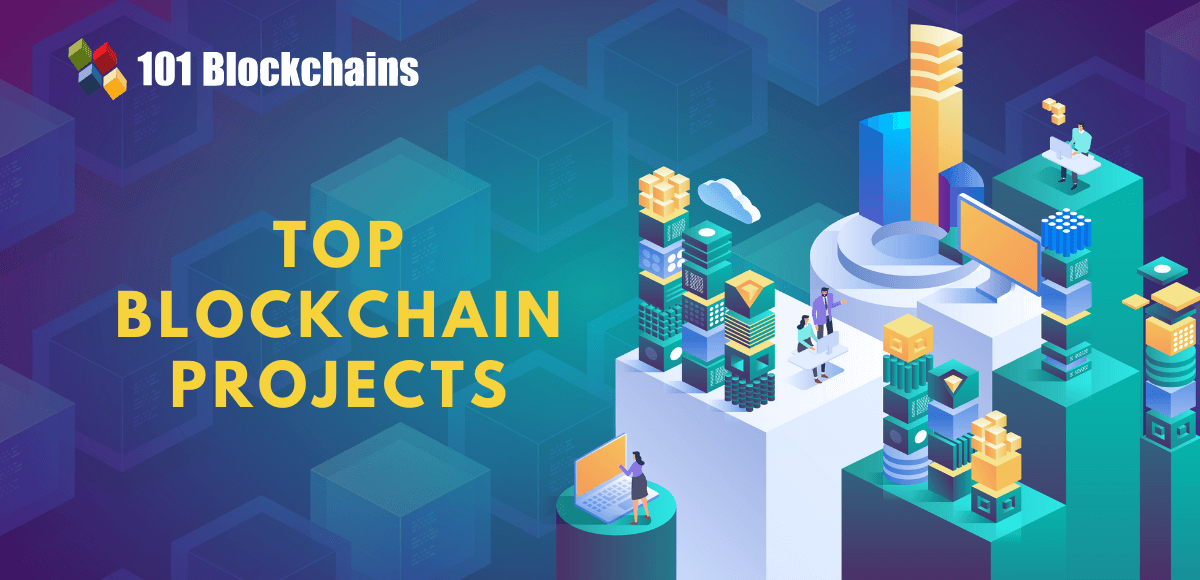Learn how blockchain truly works, master key definitions, and uncover what makes smart contracts so "smart." Dive into the fundamentals, gain valuable insights, and start your blockchain journey today!
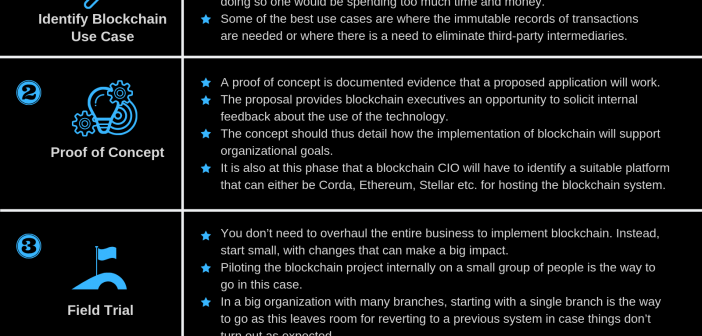
- Reviews
101 Blockchains
- on September 04, 2019
Blockchain For Executives Training Guide
The current market is extremely competitive, and that’s why you as an executive should always keep up with new technology. That’s why in this training guide we will explore blockchain for executives.
There are plenty of courses out there that teaches you about blockchain. This article aims to educate you about blockchain so that you can make better decisions and handle blockchain projects confidently.
The blockchain for executives guide is aimed towards anyone interested in learning blockchain. Top management or senior managers can also take advantage of the training guide.
Blockchain is a decentralized network that relies on peer-to-peer transactions, cryptography, and consensus algorithms.
It brings key features such as transparency, immutability, and scalability to the whole network. Until now, we never had a solution that can work without a central authority. Blockchain makes it possible to run a whole network with decentralization — enabling startups, businesses, and enterprises to solve problems in a much better way.
Who is this training aimed for?
Anyone interested in blockchain can take part in the training guide, including the following:
- C-Level managers
- Innovation manager
- Management workers
- Executives
Why do we need blockchain in the current economy?
The current economy requires innovation and growth at a rapid pace. Blockchain is bound to change our lives, but most importantly, it is going to change how our economy’s future.
The number one impact will be seen from the use of digital currencies. Even though the government does not like the idea of digital currencies, they are okay with digital currencies offered by them. India, for example, is planning to release its digital currency that will be used by billions of Indians, but a the same time, are hostile towards traditional cryptocurrencies including Bitcoin, Ethereum, and so on!
Big companies are also very interested in the idea of blockchain. Companies such as Amazon, Uber, and Facebook are pushing their blockchain projects. Facebook, especially, is en-route to release its own cryptocurrency Libra.
The economy is highly reliant on the supply chain, manufacturing, automation, food, medicine, and other industries. Blockchain is already impacting these industries. We will go through them in detail in the latter part of the blockchain for management and executives.
That’s what makes this blockchain for executives training a must for you!
Why should you take the blockchain training guide?
There are many reasons why you should take the training. Let’s go through them below.
- Change management and transformation: As an executive, you need to get acquainted with the latest technologies, including blockchain. By doing the training, you will equip yourself with the much-needed skills to help with change management and transformation.
- Gain strategic advantage: Understand what will make your company or business tick by learning about blockchain.
- Learn in-depth: Learn blockchain in-depth so that you can implement digital tokens or even run crowdfunding by completing the blockchain for executives training.
Let’s get started with our blockchain for management and executives training guide.
Blockchain For Executives Training
Module 1: Blockchain Fundamentals
In the first module of blockchain for executives training, we will go through blockchain fundamentals in brief. The module will help you what makes blockchain work and other important concepts required to understand blockchain.
Blockchain Definition
Blockchain is best defined as a network of peers, connected together without any central authority. In a public network, peers are free to send transactions or information without any restriction. Once a transaction is sent out, it is assigned to a block which is part of a big chain of blocks.
However, there is a need to reach a consensus, and it can be done using the consensus algorithm. Also, as there is no central authority, each peer carries a copy of the ledger.
Blockchain Features
Blockchain has six main vital features. They are as follows:-
- Incorruptible: The data once stored, cannot be corrupted. The information is immutable.
- Decentralized technology: It requires no use of central authority
- Enhanced security: Strong use of cryptography ensures better security.
- Distributed ledgers: Ledgers are distributed among peers meaning that no data can be modified or changed
- Consensus: Consensus is reached using the consensus algorithm.
- Faster settlements: Offers faster settlements.
You can learn more about the blockchain features here: https://101blockchains.com/introduction-to-blockchain-features/
Blockchain Benefits
So, what are the benefits of blockchain? Let’s list them below:
- Offers better transparency due to the use of distributed ledgers
- Traceability is also improved as relevant information can be stored and retrieved anytime.
- Greater speed and efficiency provided due to the removal of centralized authority.
- The cost is also reduced due to the lack of middleman and paperless transactions.
What is Distributed Ledger Technology(DLT)?
Distributed ledger technology(DLT) is an umbrella term for technologies that rely on decentralization. Blockchain is one of the popular DLT out there.
Other key DLTs out there include DAG, Holochain, and others.
Types of Blockchain
There are also different types of blockchain. The three types of blockchain include the following:
- Public → A public implementation means no restriction on who can join and use the network.
- Private → A private implementation means restricted access. It is generally used in a closed ecosystem where the only participants are members.
- Federated/Hybrid → Federated blockchains are used by enterprises who want to take advantage of both public and private blockchain. Federated blockchains are ideal for enterprises as they have to secure some aspects of their business while remaining open to other important entities that do are not within the business process. It can include customers, investors and supply chain management, and so on.
What is the consensus?
As blockchain is decentralized, there is no central authority to reach consensus. That’s why blockchain uses different types of consensus algorithms to reach consensus. There are many kinds of consensus methods, including Proof-of-Work(PoW), Proof-of-Stake(PoS), and Delegated Proof-of-Stake(DPoS). There are other popular types of consensus.
The difference between these consensus methods is how they work. Some of them are energy-efficient, while others offer a faster way of reaching a consensus within the network.
What is Blockchain-as-a-Service(BaaS)
Blockchain-as-a-Service(BaaS) offers customers, especially businesses, to leverage blockchain solutions hosted on the cloud. By using BaaS, the end-users do not have to worry about creating a blockchain from scratch. They can get started with these services and start building their complete blockchain, dApps, or smart contracts. The service provider manages the necessary tasks, including management, maintenance, and evolution of the network.
Examples of popular BaaS providers include IBM, Azure, Oracle, and SAP.
What are smart contracts?
Smart contracts are codes written to provide automation and legality in a blockchain environment. It is similar to legal papers in the real world — a smart contract when a particular condition is met.
This is extremely used in multiple scenarios, including triggering the purchase of goods when supply is low or transferring ownership of property once payment is made. Smart contracts are ideal tools for bringing automation to a system.
What are decentralized apps(dApps)?
dApps are apps that run on the blockchain. They are built with decentralization at the core. Ethereum is one of the blockchains that provides the necessary means of creating dApps. Other blockchain solutions also offer developers the ability to develop dApps.
This leads us to the end of our blockchain for executives module 1.
Module 2: Blockchain Use-Cases
With the basics cleared around blockchain, it is now time to go through some of the important blockchain use-cases. These use-cases will help you understand the real-world impact of blockchain in different sectors.
Let’s get started with the blockchain for executives module 2.
Supply Chain
Supply chain constitutes an important aspect of any business out there. Without an efficient supply chain, companies would find themselves struggling to make profits. Currently, supply chains are not transparent and efficient and suffer from a wide range of issues out there. One of those problems includes counterfeit goods.
With blockchain, everything is going to change when it comes to the supply chain. It can bring decentralization, which means more automation. It will also bring transparency to the whole network, solving the counterfeit problem. Each good can be tagged in the network, allowing the blockchain network to store different parameters about the good. So, for instance, if a food item in a food supply chain crosses its expiry date, it will automatically be discarded, or the information would be provided to the concerned authority.
Trade Finance
Trade finance can also be reshaped with blockchain. It handles financial institutions credit facilities. It is a big industry with over $10 trillion USD market size. But, with blockchain, it can become more efficient at handling the process.
The current problems that trade finance needs to go through include invoice factoring, manual contract creation, delayed payments, duplicative lading bills, multiple truth version, manual AML server, and so on.
With blockchain, almost every problem can be either solved or improved to a better step. The blockchain features, including the ability to real-time view, transparency, proof-of-ownership, and others, can make trade financing more growth-oriented.
HealthCare
Healthcare is one of the most critical sectors, and it also needs reform to become more viable. Right now, healthcare is suffering from a centralized approach that can be improved using blockchain.
The current healthcare system is non-connected, which means that patients need to carry their documents every time they visit doctors. Apart from that, the medicines counterfeit problem is enormous, which means billions of dollars loss for companies and bad health for the patients. These two problems grip the healthcare industry, and the only blockchain can improve the situation.
With blockchain, patients can now have their medical data loaded into the network — which can be used by the patient while visiting doctors. It can also help research as public data can be pulled by researchers to find a cure for the different kinds of diseases.
Blockchain’s transparency is also solved in the drug counterfeit issue. It solves it by ensuring that the medicine is not counterfeit. Each medicine delivered to the hospital or patient goes through the network — which collects vital information about it. If the details changed, it could be counterfeit.
Retail(Tracking)
Retail encompasses multiple sectors, including the supply chain. Blockchain has been used in retail in many ways. For instance, it can be used to improve loyalty programs, customer data security, management, and sharing.
Another great use-case of blockchain for retail is the crypto payments. Many retailers are interested in it as more and more people are now using crypto as one of their payments.
Retails can also store customer identity in blockchain, allowing them to share data more seamlessly among stores.
Real Estate
If you opt to buy a real estate property, you need to go through a cumbersome process of documentation, verification, and execution. It can take anywhere between weeks to months to get hold of a property. On top of that, there can be chances that someone can cheat you and sell you a property that is not owned by them.
All these problems can be solved by blockchain with the removal or decrease of real-estate agents or mediators. With smart contracts, it can become a matter of minutes before you can buy your property.
Real estate also needs to spend a lot of money on paperwork. With blockchain, it can lead to a paperless economy, saving time and expense required to make a deal successful. The use of blockchain can also mean the globalization of real estate.
Read more at Real-World Blockchain Use Cases – 46 Blockchain Applications.
This leads us to the end of our blockchain for executives module 2.
Module 3: Blockchain for Business
In our 3rd module of blockchain for executives guide, we are going to cover multiple aspects of blockchain through a business viewpoint. The module will help you understand the ways in which you can utilize blockchain or if your business actually needs blockchain at all.
Identifying key business opportunities
As a business, your job is to thrive and make your business as profitable as possible. This means using technology to your advantage, including blockchain.
So, how can you do so
The best way to approach is first to identify the pains of your business. By identifying the things that are required to improve, you can understand if you need blockchain to solve it or not.
There are five applications that you can use blockchain in your business. They include the following:
- Cloud storage which is decentralized
- Smart contracts to automate part or whole business processes
- Employment payments
- Supply chain improvement
- Quicker background checks and better hiring
- Accounting
- Business intelligence
And much more!
Relationship of Blockchain technology with emerging technologies: IoT and AI
Technologies are bound to work together rather than alone. If you are a part of a modern company or business, you should also know that you cannot progress with just one technology.
Everything is connected, and we are part of the whole ecosystem.
This is where IoT, AI, and Blockchain comes in. With millions of devices connected, sharing data among them through a network — it’s all about how efficient the systems need to be. For the network, we can utilize blockchain. It acts as a memory and ensures data integrity, transparency, and security in IoT environments.
To make sense of data, AI can help. AI acts as the thinking brain of the whole setup where it can train itself to understand both structured and unstructured data.
In short, all these three are intertwined together. If you want to build a sustainable future, then each of these technologies needs to be part of the growth.
Does your business need blockchain?
It is easy to get driven by the change rather than understanding the true need for it. Blockchain has become the norm for many companies where they are adopting it or plan to adopt it in the future.
But do you need it?
Let’s find out by going through the five questions that will help you decide whether blockchain is a good fit or not.
- Do you want data immutability? If the answer is yes, then you need blockchain as the centralized database is not capable of data immutability.
- Is data multi-source or single source? If your data is coming from multiple sources and you also want data immutability, then you need blockchain. If you are an internal organization with no external data source, then it is better to use a centralized approach as there is already trust within the ecosystem.
- Do you require intermediary? If you do, then you can maximize your needs through a centralized database. If you do not, then blockchain is what you need.
- Do participants know each other? If they do, then there is no need for a decentralized solution as there is already a trust setup between them.
By answering the above questions, you will be able to understand your requirements. Even if you come up with the need of blockchain, you also need to evaluate the true impact of the change. If the yields are not great, it is better to stick with your current system.
This leads us to the end of our blockchain for executives training module 3.
Module 4: Regulatory/Legal Implications of blockchain
In this 4th module of blockchain for executives training, we will be covering the regulatory and legal implications of blockchain. Blockchain is hard to regulate or have legal bindings. After all, it is a decentralized solution that brings a steep challenge to the authorities that are in power.
Regulations
To get a grasp, we will go through the regulatory environment in the US. Currently, the federal government is not interested in regulating blockchain technology. This means that each state has to set up its regulatory agencies. The good news is that the regulations are in favor of the blockchain-based contracts or other features that blockchain has to offer.
Currently, many states have no regulations in place, while others have partial and some have complete rules in place. So, if you are a working executive in the US, you need to check out the regulations of the state in which your company offers service or resides in. This will help you prepare yourself. The future does look bright as the government is in favor of the blockchain technology, and is also working towards incorporating it in their systems.
The European Union also has a positive outlook for blockchain.
Legality
The legality aspect is far-stretched than regulations as it covers a wide scope. For instance, a blockchain solution can be global, meaning it has to meet the legal bindings of different countries. This can be very challenging, especially for states that have a completely different type of governance.
This can lead to issues in service levels and the performance of a blockchain solution. The liability aspect is also one of the major legal issues. As most of the blockchain networks are decentralized, who is responsible if something goes wrong?
Data privacy is another legal issue. The current centralized systems are capable of forgetting information. But, with blockchain, this won’t be possible as it has data immutability is one of its key features. This can pose a severe threat to privacy, and anyone who participates in a network will not have the right to “forget.”
This leads us to the end of our blockchain for executives training module 4.
Module 5: Blockchain Challenges
Blockchain is a considerably new technology. This means that it is hard to implement. There are many challenges that one needs to overcome to make proper use of blockchain technology, especially when it comes to implementation.
Let’s get started with our module 5 of blockchain for executives training.
Blockchain Implementation Challenges
To get an idea, let’s go through the key blockchain implementation challenges.
Cost: Implementing a blockchain can be a tough task. It requires spending a lot of money. One of the main reasons include how blockchain operates and the lack of skilled developers at a reasonable price.
Scalability: Blockchain scalability is a big concern when it comes to enterprise usage. However, with a new blockchain solution arriving, it is the only time when scalability issue can be resolved. Right now, blockchain can scale with the help of cloud computing.
Data Privacy: The data privacy issue is one of the biggest challenges. As blockchains are distributed ledgers, it is hard to protect data from being shared between nodes. Cryptography is used to encrypt data, but it doesn’t solve the core problem. Also, once the data is written, it cannot be erased.
Insufficient blockchain literacy: Another big challenge is inadequate blockchain literacy. Even though you implement it correctly, you need to educate people on how to use it efficiently. It can be a severe challenge considering that people do not want to change in the way they work or think.
You can find the top 10 enterprise blockchain implementation challenges here:
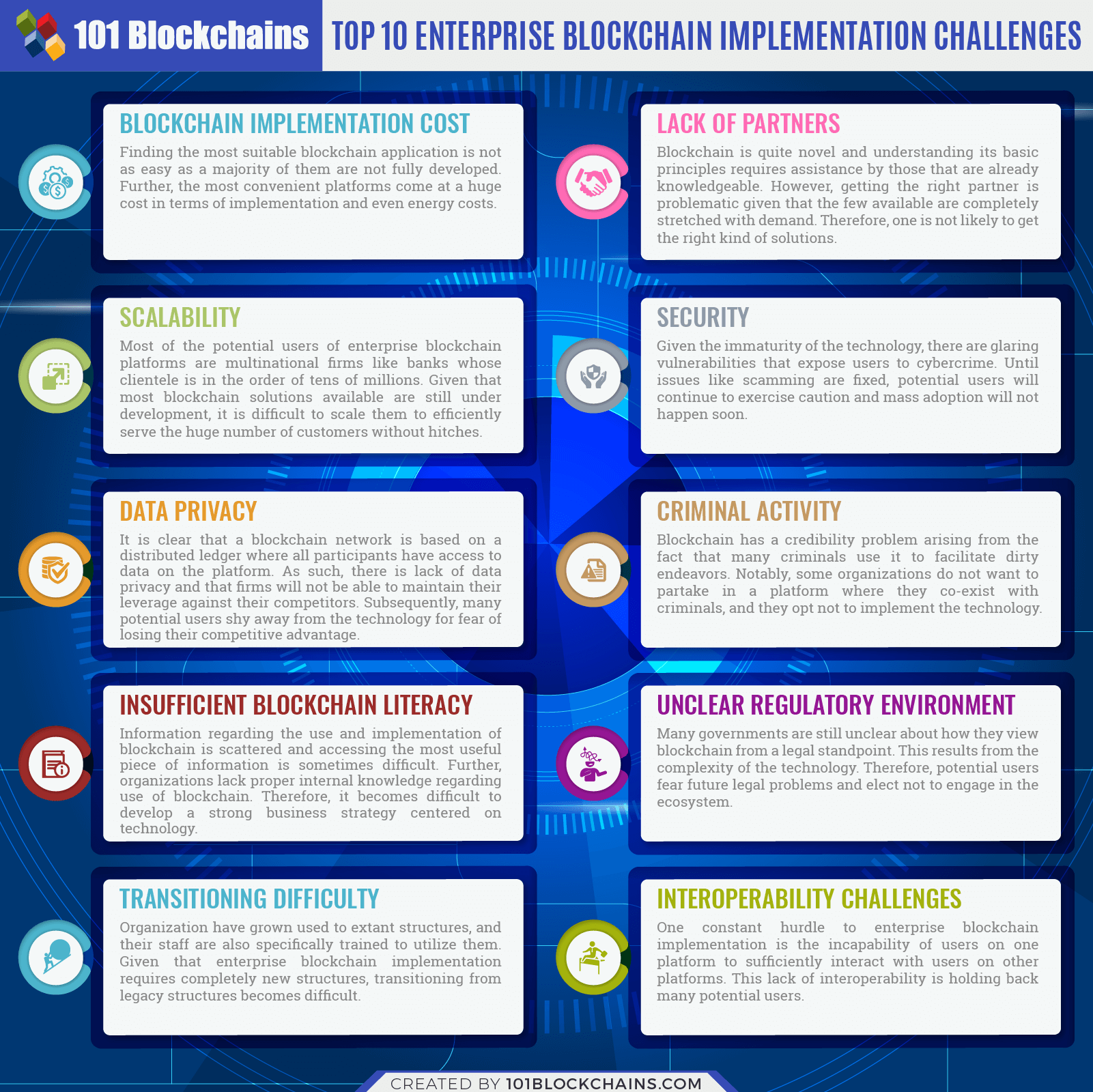
Top Blockchain Adoption Challenges
In our blockchain for the executive training guide, we will also be covering the reasons why blockchain adoption is hampered.
Let’s list them below:-
- Lack of skilled developers
- Energy-inefficient consensus mechanisms
- Poor regulations over blockchain
- Questionable security
- Scalability
- Standardization issue
- Integration
This leads us to the end of blockchain for executives module 6.
Conclusion
This leads us to the end of our blockchain for managers guides. We covered important topics, including the basics, regulations, challenges, and more in our blockchain for executives training.
By completing the full training, you can also take up challenging positions such as blockchain innovation manager or blockchain C level employees. This training opens up the blockchain world for you, and it depends on you what you want to do with that knowledge.
So, what do you think about the executive training guide? Comment below and let us know.



